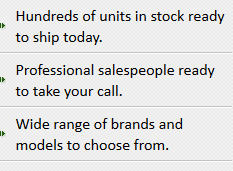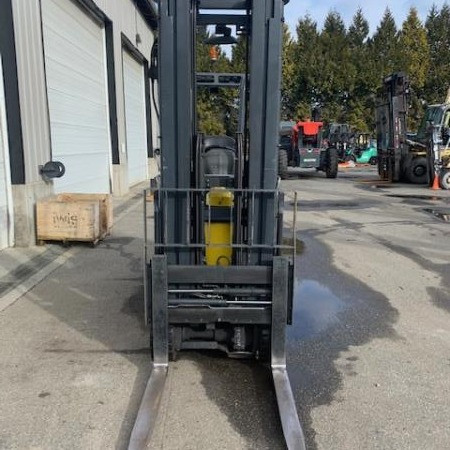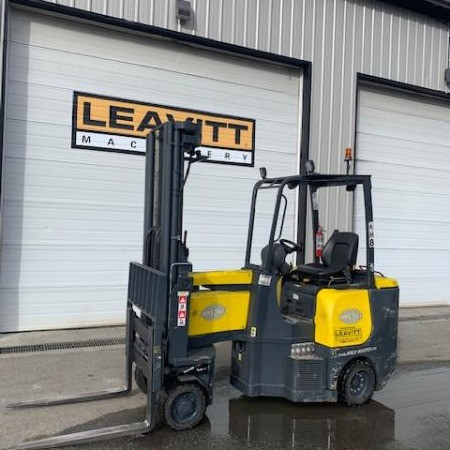Very Narrow Aisle Forklift Tempe
Used Very Narrow Aisle Forklift Tempe - Getting items from one warehouse location to another and to and from the loading docks is the focus of warehousing. Focus is often on space saving tools and the layout of the building. Very narrow aisle solutions allow for more space to be dedicated to the storage of goods because less space is required for aisle access. These warehouse configurations are often referred to as warehouse optimization.
Warehouse Optimization
Several benefits can be enjoyed for adding very narrow aisle warehouse optimization such as more storage space for the facility.
Since very narrow forklift trucks have been designed to take up significantly less space, warehouse aisle widths can be reduced to half the width needed by traditional forklifts. Certain models of very narrow aisle forklifts can increase the square foot storage capabilities by delivering greater stacking heights. Costs can be drastically decreased with a narrow aisle forklift compared to a standard aisle configuration as less warehouse space is required for the same quantity of stock. Square footage is costly in urban areas and any way to reduce warehousing costs can save a company money. Warehouse storage can be increased up to eighty percent with careful planning when a narrow aisle width configuration is utilized. Very narrow aisle design facilitates greater product access and more rack faces. Reduced travel time for storing items and gathering products are some of the key benefits to this warehouse layout as more products are found in an accessible location.
Warehouse layouts usually utilize a narrow aisle or very narrow aisle plan. Narrow aisles are usually those that use less than 11 feet of aisle width. Very narrow aisles usually use an aisle width of approximately 6.5 feet across. Both of these aisle widths provide significantly increased storage opportunities. Standard forklifts can have issues with turning in these aisle widths. These challenges are met by using very narrow forklifts to gain access and complete tasks.
Before choosing a forklift for a particular job, it is vital to know the dimensions of the aisle. Having the right aisle dimensions will save money and time instead of purchasing the wrong forklift that won’t be able to conquer the applications. It is essential to take any columns, posts or utilities into account before deciding a type of narrow aisle forklift design as these can block access.
Very Narrow Aisle Forklift Trucks
Rechargeable batteries are typical for powering very narrow aisle forklift trucks and most models are electric. These very narrow aisle trucks are more commonly available as stand-up riders, which helps increase productivity and operator comfort. The most commonly used types of very narrow aisle forklift trucks are:
1. Reach trucks
2. Order pickers;
3. End-control riders; and
4. Turret or swing-mast.
Reach Forklift Trucks
Developed as a kind of rider stacker forklift, the reach forklift trucks can be configured for narrow aisle locations. The reach trucks developed their name from their forward-reaching actions to get a load. The moving mast and the moving carriage are two types of reach trucks. The moving carriage functions by lowering and raising the carriage and the operator. The moving mast raises and lowers the forks as the operator remains at ground level. The moving reach truck is typically considered the safest out of the two kinds of reach trucks. These machines rely on a kind of jointed framework known as a pantograph system that enables the operator to place a load or reach the load without moving the machine.
Order Pickers
Order pickers have been created to pick items from difficult, high racking systems. Order pickers are specific for lighter stock items that can be lifted by hand. They lift the operator up to reach the goods by identifying and choosing certain items to create an order.
End-Control Riders
End-control riders can pick up loads along the floor level and transport goods horizontally instead of transporting items over heights.
Turret or Swing-Mast Forklift
Swing-mast or turret very narrow aisle forklifts feature an articulating swivel mast that pivots. Pallets can be set on either the right or left side of the forklift due to the machine’s ability to use its’ swinging mast.
Guided Very Narrow Aisle Trucks
Rail or wire can guide the very narrow aisle forklift trucks down the aisle securely.
Since the forklift truck is guided, the chance of colliding with racks while traversing down the aisles is very low. For rail-guided systems, a series of rails are installed into the floor, on both sides of the aisle, and run along the floor for the length of the aisle, curving around the end of the aisle. Specific wheel guides are on the forklift. These slide into the rails to stop the forklift from moving out of the rail guards.
The wire-guidance system requires that the wires be installed into the floor, along the center of the aisle. Narrow aisle forklifts rely on a wire-guide system to help it communicate with the floor wires. This allows the machine to be steered by the wires, stopping it from traveling outside of the specific location.
Work Site Considerations
Certain essential considerations need to be dealt with before using a narrow aisle configuration. Because these very narrow aisle configurations include very tall racking systems, the condition of the floor and the construction of the racks must be done properly in order to avoid potentially disastrous outcomes. Four specific areas need to be perfectly prepared before a racking system can be implemented including a level floor, plumb racks, any floor cracks need to be repaired and the floor’s load capacity must be accurate. These locations need to be maintained and monitored continuously.
Level Floor
Because of the height of the racking systems, any slight slope of the floor is likely to negatively affect the plumbness of the racks, especially over time when loads are continuously placed and removed on the racks. Without a level floor foundation, the rack stability could be compromised.
Crack Repair
When there are floor cracks found, they need to be assessed and immediately fixed for safety concerns. Safety can become compromised when flooring cracks become 3/8 inches wide. They require proper filling with a substance that is as hard as the floor.
Floor Load Capacity
The floor should meet certain minimum requirements before considering a narrow aisle configuration. The floor should have three thousand psi concrete minimum and contain evenly distributed rebar at three to four inches under the surface. Depending on the load requirements and configuration, additional reinforcements may be needed.
Plumb Racks
The racking system is essential to the whole process and needs to be installed properly. If installed improperly, there is a great chance of rack failure. Every rack needs to be plumb to ensure a safe system and work environment. Rack shims are recommended to make sure the racks are plumb within one inch at the thirty- foot rack height.
If the above measures are not taken or are improperly implemented, it is likely to cause a racking failure. Such failure is likely to result in costly damage to goods, the warehouse facility, forklifts and, worst of all, employees could be significantly injured or even killed. Due to these potential problems, the most significant part of creating a narrow aisle configuration for warehousing optimization is the initial measurements.
Very Narrow Aisle Forklift PDF
Stock Number: 207213 GL
Make: AISLEMASTER
Model: 44E
Year: 2013
| Stock Number |
207213 GL |
| Make |
AISLEMASTER |
| Model |
44E |
| Year |
2013 |
| Category |
Very Narrow Aisle Forklift |
Stock Number: 209213 GL
Make: AISLEMASTER
Model: 44SE
Year: 2015
| Stock Number |
209213 GL |
| Make |
AISLEMASTER |
| Model |
44SE |
| Year |
2015 |
| Category |
Very Narrow Aisle Forklift |
Stock Number: 208758 GL
Make: AISLEMASTER
Model: 44SE
Year: 2015
| Stock Number |
208758 GL |
| Make |
AISLEMASTER |
| Model |
44SE |
| Year |
2015 |
| Category |
Very Narrow Aisle Forklift |













